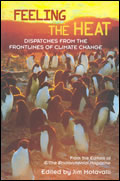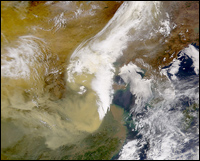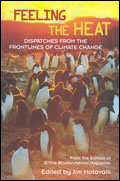This piece is excerpted from Feeling the Heat: Dispatches From the Frontlines of Climate Change. Other contributors to the book include writers Ross Gelbspan, David Helvarg, and Mark Hertsgaard and photographer Gary Braasch.

Feeling the Heat:
Dispatches From the
Frontlines of Climate
Change
Edited by Jim Motavalli,
Routledge, 176 pages,
2004
The Indian city of Mumbai, formerly Bombay, is home to one of Asia’s largest slums and endures among the worst air quality on earth. Half the city’s population lacks running water or electricity, and the smoke from countless wood-burning cooking fires joins with the acrid haze from two-stroke auto rickshaws, diesel buses, and coal-fired power plants to all but choke the city. Breathing Mumbai’s air, reports the Lonely Planet travel guide, is equivalent to smoking 20 cigarettes a day. Comparable air quality wraps New Delhi, Bangalore, and 69 of India’s 70 principal cities year-round, according to a 1997 study by India’s Central Pollution Control Board.
But the nation’s air-pollution problem doesn’t stop at street level — or, for that matter, at the level of city, region, or even nation. U.S. military pilots flying over the Indian Ocean in the 1980s were the first to detect a large, dense cloud of soot floating far above Asia. Since then, the so-called Asian Cloud has shown up regularly in satellite photographs.
In 1999, a team of scientists funded by the National Science Foundation began a $25 million surveillance of the Indian Ocean. The team discovered that the Asian Cloud hangs at an elevation of one to two miles above the earth’s surface and covers 6 million square miles* — about the size of the continental United States, and only slightly smaller than the ozone hole at its peak in 2000. The cloud floats over the northern Indian Ocean, the Arabian Sea west of Mumbai, and the Bay of Bengal. The source is air pollution from India and China, produced by hundreds of millions of wood, coal, and oil fires — a dense haze blown out to sea during the winter monsoon season.
When the cloud was first discovered, scientists were astounded by its size and troubled by its composition. Its tiny sun-blocking particles called aerosols — a complicated chemical soup of soot, sulfates, nitrates, ash, and dust — exist in gigantic concentrations and have the power to block sunlight, potentially influencing climate nearly as much as carbon dioxide.

No silver lining on this cloud.
Photo: NASA.
“The local effect is well-known, because wintertime [smog] can sometimes close airports in India and Pakistan for weeks. But it was not known that [the cloud] had spread over the entire ocean. It stunned us to discover how pervasive these aerosols are,” said Veerabhadran Ramanathan, a professor of atmospheric and ocean sciences at the Scripps Center for Clouds, Chemistry, and Climate and codirector of the U.N.’s Indian Ocean Experiment (INDOEX).
In August 2002, Ramanathan and Paul Crutzen of Germany’s Max Planck Institute for Chemistry released the first comprehensive scientific study on the Asian Cloud under the banner of the United Nations Environment Program. The report is based on INDOEX studies from more than 200 scientists in Europe, India, and the U.S. The researchers found that the two-mile-thick pollution cloud, though it probably affects everyone on the subcontinent, hits vulnerable people especially hard. It may already be a factor in the premature deaths of a half-million mothers and children under age 5 in India annually, says one INDOEX study. It also contributes to nearly 700,000 air pollution-related deaths worldwide every year — which could climb to 8 million by 2020.
The soot cloud also reduces the amount of solar energy hitting the earth’s surface by as much as 15 percent, interfering with photosynthesis. It could potentially cut India’s rice harvest by 5 to 10 percent — a sobering forecast for a nation where hunger is already an issue and the population is expected to grow to 1.6 billion people by 2050, overtaking that of China to make India the world’s most populated country.
Ramanathan also worries about the unknown effects of the Asian Cloud on life in the world’s oceans. “The haze causes a loss of sunlight striking the surface of the sea, and we are just starting research on how that affects photosynthesis and ocean plankton,” he said. In still another unmeasured impact, aerosols in the cloud get caught up in regional thunderstorms, falling into oceans as acid rain and potentially harming sea life.
The cloud could also aggravate existing environmental problems like the looming Third World water crisis. Aerosols block sunlight that causes evaporation at the ocean’s surface, and thus interfere with natural rain patterns. “In my own work, the most worrisome effect is on the water cycle of the planet,” Ramanathan said. “This is the century for water shortages, and the last thing we need is this particulate effect, but we appear to be stuck with it.”
Ramanathan and other scientists have shown that brown-cloud particulates are likely to be affecting and complicating global warming, though in ways that are not yet fully understood. We do know that the Asian Cloud “is having a cooling effect on the [earth’s] surface, but at the same time is also warming the atmosphere,” Ramanathan said. The cloud may already be adversely influencing regional climate. Barry Joe Huebert, a University of Hawaii atmospheric chemist, thinks that the loss of ocean sunlight may be dramatically altering Asia’s whole hydrological cycle, disrupting the monsoons and contributing to a pattern of severe droughts, storms, and erratic rains in Asia over the last decade. According to The Guardian, the disruption of once-predictable monsoon rains is having an impact on agriculture “and adversely affecting the health and livelihoods of up to 3 billion people throughout Asia.” In May and June of 2003, southern India endured an unprecedented month-long heat wave with temperatures of 120 degrees Fahrenheit that claimed more than 1,500 lives, according to the World Meteorological Organization.
There is also bad news for the U.S. and other nations: The Asian Cloud doesn’t stay put. Scientists say that it can probably travel around the world in less than a week, carried on upper atmospheric winds. According to David Parrish of the National Oceanic and Atmospheric Administration Aeronomy Lab in Boulder, Colo., recent research reveals that Asian soot particles are “piggybacking” on immense Asian dust clouds, catching a free ride to the West Coast of the United States. “When [dust and soot] particles run into each other they tend to stick together,” he said. “It’s all being transported on the same air mass.”
The implications of the global transport of air pollution are still uncertain. “We’re beginning to feel our way around the elephant,” Parrish said. “Only a relatively few episodes have been studied in detail.” But the net effect, he believes, is an increase in both global warming and coastal pollution. “The dust tends to scatter solar radiation back into space, while the soot absorbs it, heating the atmosphere.”
Parrish notes that a study of springtime ozone levels in California showed that they had increased by a third between 1985 and 2002. “We can point to Asia as the likely cause, but we have no clear evidence,” he said. “The increase was larger than we had expected, and it reduces the latitude we have to mess up our own air.”
Don’t Blame Me!
The political response to revelations about the Asian Cloud by Ramanathan and others has been largely hostile. Ramanathan’s studies of the phenomena were made public in the summer of 2002, and his future, and the future of Asian Cloud research, has since been threatened by Indian politicians who were incensed that their country was being singled out.
India’s environment and forests minister, T.R. Baalu, even defended the Asian Cloud with a rather twisted bit of environmental-justice illogic. He claimed that India’s stupendous emissions are a “necessity” because its people are poor and have no choice but to burn animal dung, wood, and charcoal. True enough — but it hardly explains why the minister stayed silent regarding India’s lack of rigorous auto-emission controls and the related health problems stemming from poor air quality and borne largely by the poor.
The political outcry has thus far resulted in turning a blind eye to the cloud — and in a loss of funding for the U.N.’s INDOEX work. Some United Nations research will likely continue, but the U.N. has cautiously replaced the term “Asian Cloud” with the generic phrase: “Atmospheric Brown Cloud” so as not to implicate any nation — or even continent — as the source.
Meanwhile, India’s citizens have made several mostly fruitless attempts to clear the air. The country’s best-known tourist attraction prompted one such effort. Over recent decades, tourists have watched the Taj Mahal’s marble facade fade from dazzling white to dingy yellow, and its dome begin flaking away under a relentless attack by acid rain.
Mahesh Chandra Mehta, a prominent environmental lawyer in India, filed suit in the Indian Supreme Court in 1984, claiming that pollution was ruining not only the Taj, but also the health of the people of Agra, the city where the monument is located. Twelve years later, in 1996, the court ruled in favor of Mehta. Coal-based brick kilns were ordered shut down. The biggest factory in Agra, Sterling Machine Tools, switched from coal power to natural gas. Some 292 coal-based industries were asked to switch to gas fuels or close by the spring of 1997. For all this, Mehta won the Goldman Environmental Prize.
But the health of the Taj and of millions of Indians is still in serious danger. Despite the court order to clean up Agra, progress has been slow. Many small companies lack the funds to make the costly switch to natural gas. The basic cost for each conversion, according to UNESCO, is $75,000 to $100,000 — a quarter of annual sales for many companies. Agra’s Iron Founders Association has also fought back, claiming that natural-gas technology isn’t ready yet and that shutting down foundries would idle 30,000 workers. Faced with closure, factory workers burned their bosses in effigy.
By 2000, Agra had moved cars and some small shops away from the immediate vicinity of the Taj, but few factories were shut down. Tourists, 1.8 million of them annually, now reach the landmark in a small fleet of electric vehicles, a belated and probably futile attempt to preserve Shah Jahan’s 17th century palace from pollution.
Cloud-Cuckoo Land
While the environmental impacts and politics surrounding the cloud remain complex and unresolved, the steps needed solve the problem are clear. “There are solutions,” David Viner of the Climatic Research Unit at the University of East Anglia told the BBC. “Stop burning the forests, switch to less-polluting fuels, and introduce clean-air technology, like scrubbers on power-station chimneys. They’re simple to work out. Unfortunately, they’re rather more difficult to implement.”
As the Asian Cloud’s threat becomes global, some argue that the cleanup bill should be shared, rather than dumped on the backs of India’s poor. In 2000, then-U.S. President Bill Clinton visited the Taj Mahal to sign an environmental agreement providing $45 million for energy-efficiency programs in India — a good start, but little funding has been forthcoming since.
Resolving the problem at the source will require a new infusion of global will, said Margaret Hsu and Laura Yee in a recent online report. They argue that the West must pay attention to the air pollution generated by developing nations: “The obvious, but perhaps less-attainable, solution is to distribute more efficient sources of energy and better technology to the masses,” they write. “Once the majority of India and China is lifted out of poverty, theoretically they will no longer need to burn biofuels, and the dominant cause of the cloud will have been eliminated … [I]f people in the United States believe the Asian Brown Cloud to be a threat and are truly concerned, they also have a responsibility to fix the problem. This may include developing more efficient technology, and … making it more available and affordable.”
Until such a time comes, the Asian Cloud will likely continue growing. Joseph Prospero, a professor of marine and atmospheric chemistry at the University of Miami and an INDOEX participant, acknowledges the power of this dark shroud to do great planetary harm: “Anyone who’s ever been to India knows there’s a lot of pollution there. It’s scary, and it’s the way it will go in all of Asia.”
And as goes Asia — home to 60 percent of the planet’s 6 billion-plus people — so may go the world.
*[Correction, 04 Oct 2004: This article originally stated that the Asian Cloud covers 10 million square miles.]



